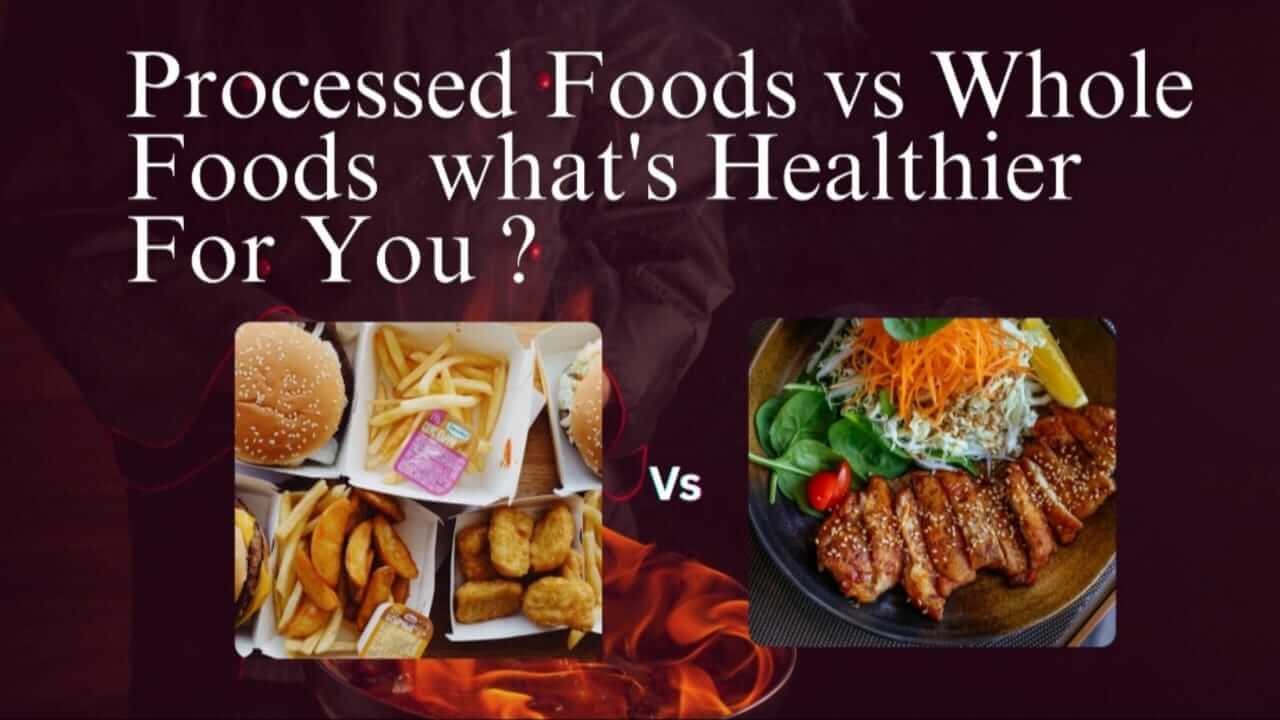
In today’s fast-paced world, the food choices we make significantly impact our health and well-being. From supermarket shelves packed with packaged snacks to farmers’ markets full of fresh produce, the contrast between whole foods and processed foods has never been more apparent. But what are the real differences and how do they affect your health?
This guide breaks down everything you need to know about whole foods vs. processed foods, including definitions, health impacts, and smart tips for choosing nutrient-dense foods every day.
What Are Whole Foods?
Whole foods are ingredients in their natural or close-to-natural state. These have undergone little to no processing and retain most of their original nutrients.
Examples
- Fresh fruits and vegetables
- Whole grains like brown rice, oats, and quinoa
- Nuts and seeds
- Eggs, fresh fish, and lean meats
- Beans, lentils, and other legumes
- Pasteurized milk and plain yogurt
These are typically nutrient-dense, meaning they provide a high amount of vitamins, minerals, fiber, and antioxidants per calorie. This makes them a cornerstone of healthy eating and weight management.

What Are Processed and Ultra-Processed Food?
Nearly all eating undergo some level of processing chopping, freezing, fermenting, or drying. But not all processed food are created equal.
Understanding Food Processing Levels:
The NOVA food classification system classify into four categories:
- Group 1: Unprocessed or minimally processed foods
e.g., raw vegetables, frozen fruit, boiled eggs - Group 2: Processed culinary ingredients
e.g., salt, oils, butter, sugar usually added to Group 1 during cooking - Group 3: Processed foods
e.g., canned beans, fresh bread, cheese - Group 4: Ultra-processed food
These are highly processed food containing ingredients not found in a typical home kitchen, such as artificial flavors, preservatives, and sweeteners.
Examples
- Sugary breakfast cereals
- Frozen meals and boxed pasta
- Packaged snacks like chips and cookies
- Sweetened yogurt and soft drinks
- Energy bars and meal replacement shakes
These are often contain food additives like emulsifiers, thickeners, and colorants. While they’re convenient, they tend to be lower in fiber and protein, and higher in added sugar, sodium, and unhealthy fats.

Key Differences Between Whole and Processed Food
Let’s break down the differences between healthy and processed food across several key dimensions:
1. Nutritional Value
Whole foods are naturally rich in essential nutrients, fiber, and antioxidants. In contrast, highly processed foods often lose valuable nutrients during manufacturing and contain added sugars and refined carbs.
Example: A plain baked potato (whole food) provides fiber, potassium, and vitamin C, while potato chips (processed) offer fewer nutrients and more calories from fat and salt.
2. Caloric Density
Ultra-processed food are typically more calorie-dense due to added sugars and fats, contributing to weight gain if consumed regularly.
3. Ingredient Quality
Whole food contain ingredients you recognize like spinach, oats, or almonds. Highly processed food often list artificial additives, preservatives, and refined oils on their labels.
4. Satiety and Cravings
Whole food promote satiety and stable energy. Processed foods are often designed to be hyper-palatable, which may lead to overeating and sugar cravings.
Health Impacts of Processed vs. Whole Foods
Multiple studies link ultra-processed food consumption to a higher risk of chronic diseases, including:
- Heart disease
- Type 2 diabetes
- Obesity
- Cancer
- Digestive issues
In contrast, diets rich in whole food like the Mediterranean diet are associated with:
- Improved heart health
- Balanced blood sugar
- Reduced inflammation
- Healthy aging
- Better gut health
Nutrient-dense whole food list: Leafy greens, berries, avocados, fatty fish (like salmon), legumes, and whole grains are especially powerful for long-term health.
Should You Avoid Highly Processed Food?
You don’t need to completely eliminate ultra-processed food to maintain a healthy diet. The goal is moderation and making real food the foundation of your eating habits.
Why Avoid Ultra-Processed Food (Most of the Time)?
- Often high in empty calories and sugar
- Low in nutrients and fiber
- May disrupt gut health
- Can contribute to weight gain and inflammation
When Are Processed Food Okay?
- Canned beans or frozen vegetables (minimal processing)
- Whole-grain bread with few ingredients
- Greek yogurt without added sugar
- Meal kits featuring whole food ingredients
The key is to read labels and choose options with minimal additives and recognizable ingredients.
Tips for Choosing Better Options
Here are some practical ways to reduce your intake of highly processed foods:
1. Cook at Home
Home cooking gives you control over what goes into your meals. Use meal kits if you’re short on time but still want healthy food.
2. Shop the Perimeter
In grocery stores, the perimeter usually houses whole foods like produce, dairy, and meat.
3. Read Ingredient Labels
Avoid products with long ingredient lists full of items you can’t pronounce. Look out for added sugars, refined oils, and preservatives.
4. Focus on Food Freedom
Don’t stress over the occasional treat. Enjoy your favorite packaged snacks or desserts mindfully, while making healthy eating the norm.
5. Support Food Sustainability
Buy from local farmers’ markets when possible. Supporting sustainable agriculture also ensures you’re getting fresher, less processed food.
Conclusion:
The debate of real food vs. processed food isn’t about perfection it’s about making informed, balanced choices. Whole food offer unmatched nutrition, help with weight management, and reduce disease risk. Highly processed food, while convenient, should be enjoyed occasionally not as the foundation of your diet.
By embracing a nutrient-dense, whole food-based lifestyle, you’ll not only feel better but also reduce your reliance on food high in artificial additives and empty calories.
FAQs
1. What are highly processed foods?
Highly processed foods, also known as ultra-processed food, contain ingredients not typically used in home kitchens such as artificial sweeteners, preservatives, and colorings. Examples include soda, packaged snacks, and frozen meals.
2. What are healthy foods?
Healthy foods are generally whole or minimally processed foods that provide essential nutrients. Think fruits, vegetables, lean proteins, whole grains, and healthy fats.
3. Should you avoid highly processed food completely?
Not necessarily. It’s okay to enjoy your favorite treat in moderation. The focus should be on building a diet that’s mostly made up of real, nutrient-dense food.
4. What is the difference between healthy and processed foods?
The main difference lies in their nutrient content and processing level. Healthy food are nutrient-rich and minimally altered. Processed foods often contain added sugars, salt, and fats with fewer nutrients.
5. How can I eat less processed food?
Start small. Replace soda with unsweetened tea, swap packaged snacks for fruits or nuts, and cook more meals at home using whole food ingredients.

